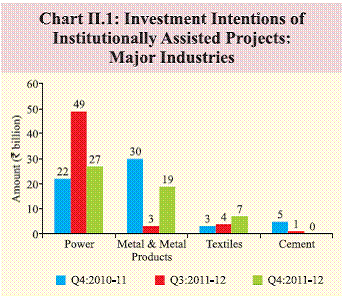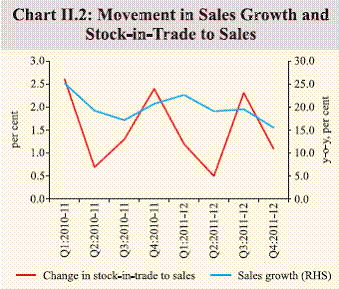 IST,
IST,
II. Aggregate Demand*
Reflecting the slowdown in the domestic economy, growth in aggregate demand weakened further during Q4 of 2011-12. The decline in investment, particularly private corporate investment, has emerged as a major drag on demand. From a long-term perspective, the sustained fall in investment so far has impacted India’s growth potential. Some moderation in private consumption is also taking place, partly due to the impact of inflation on purchasing power. Corporate sales decelerated along with continued decline in profits and could adversely impact investments ahead. In this situation, crowding-in of private investment demand by public investment spending stimulus while aggressively cutting expenditure on subsidies hold the key to growth revival. Expenditure side of GDP continued to show weak demand II.1 The expenditure side aggregates, based on the revised estimates of national income released by the CSO in end-May 2012, are indicative of slackening demand conditions in the economy (Table II.1). This assessment however, is strongly influenced by the ‘statistical discrepancy’ in the data. For example, the sum of the contribution-weighted growth rates of the different expenditure components in Q4 of 2011-12 works out to 9 per cent, which is much higher than the growth rate of 5.6 per cent derived from the supply side after adjusting for net indirect taxes (Table II.2). Such ‘statistical discrepancy’ is also reflected in the incorrect manifestation of external demand through positive net exports in Q4 of 2011-12 in contrast to the record current account deficit posted in the data that were released by the Reserve Bank in end-June 2012.
II.2 Keeping aside the apparent statistical weaknesses in the data, the moderation in expenditure persisted in Q4 of 2011-12, which was reflected across private and government final consumption expenditure and subdued growth in capital formation. Growth slowdown is reflected in weaker growth in private consumption and investment II.3 The growth in private final consumption expenditure, which accounts for around 60 per cent of GDP, decreased in Q4 of 2011-12. The subdued levels of gross fixed capital formation (GFCF), which accounts for around 30 per cent of GDP, can be partly attributed to high interest rates but non-monetary factors have also played a significant role. In this context, it may be mentioned that real interest rates in the recent period are lower than their levels in the precrisis years when investment rates were much higher. The moderation of investment in the recent period, therefore, suggests that there are factors other than interest rate at play. Empirical estimates in a recent Reserve Bank Working Paper show that the real interest (lending) rates explain only around one-third of real GDP growth. In the post crisis period, the slackening of investment is mainly related to the private corporate sector. In addition, the share of public investment in GDP has declined. Apart from the erosion in corporate profit margins and already high leverage, other domestic and global factors have contributed to weakening investment activity. Investment outlook remained insipid in Q4 of 2011-12 II.4 Corporate investment intentions remained depressed. The aggregate project cost envisaged from the new projects sanctioned financial assistance by banks/FIs, have continued to moderate through 2011-12 aggregating `2.1 trillion in 2011-12, down from `3.9 trillion in the previous year (Table II.3). Industry-wise analysis revealed that the share of the power sector in the total envisaged project cost remained the highest in Q4 of 2011-12 followed by metal & metal products and textiles (Chart II.1). II.5 The time-phasing details of projects that have been sanctioned institutional assistance for various years up to 2011-12 indicate that total intended capital expenditure by private corporate (non-financial) firms declined in 2011-12 and can be expected to decline further during 2012-13 as planned investment in new projects is likely to remain low (Table II.4). Overall, declining trend in investment demand from the private corporate sector has emerged as the major drag on overall investment.
Moderation in sales growth coupled with high input cost pressures led to declining corporate profits II.6 Sales growth for select Non-Government, Non-Financial (NGNF) listed companies by and large held up during 2011-12, though there was a perceptible drop in the last quarter (Table II.5, II.6). However, persistent pressure from input costs and rising interest outgo, led to decline in net profits (PAT). Operating and net profit margins declined during 2011-12 indicating a weakening pricing power for Indian corporates.
II.7 Growth in sales (y-o-y) remained strong in the first three quarters of 2011-12 before moderating in Q4 of 2011-12. On a sequential basis, however, sales picked up in the latter half of the year. During Q4 of 2011-12, there was also some decline in the rate of growth of input costs as well as interest outgo on a year-on-year basis. The build-up in inventory, however, was lower in Q4 of 2011-12 partly neutralising the higher built-up observed during the previous quarter.
II.8 Along with the decline in sales growth, the stock-in-trade to sales ratio has also declined in Q4 of 2011-12 (Chart II.2). This decline points towards a pessimistic corporate outlook for demand conditions ahead. High deficits limit fiscal space for reviving private investment II.9 The centre’s gross fiscal deficit (GFD) rose sharply to 5.8 per cent in 2011-12 from 4.9 per cent in 2010-11, with revenue deficit constituting over three-fourths of GFD as against 67.5 per cent a year ago. The widening of revenue deficit in 2011-12 reflected the impact of the economic slowdown on tax revenues with the revenue receipts-GDP ratio in 2011-12 turning out to be lower than even the crisis years of 2008-09 and 2009-10. Although the revenue expenditure-GDP ratio declined in 2011-12, this was at the cost of development revenue expenditure. Notably, subsidies increased to 2.5 per cent of GDP. With the large and growing revenue deficit constraining the fiscal space for investment expenditure, the capital outlay to GDP ratio declined to 1.6 per cent, well below the precrisis level of over 2 per cent.
II.10 Preliminary data indicates that the combined revenue and fiscal deficits of the centre and states as a proportion of GDP increased by 1.2 percentage points and 1.3 percentage points, respectively, in 2011-12 over the previous year, with over 80 per cent of the increase contributed by the centre (Table II.7). Combined development expenditure-GDP ratio increased in 2011-12 on account of the states (Table II.8). Likely overshooting of subsidies pose fiscal risks during 2012-13 II.11 Achieving fiscal consolidation as envisaged in the budget for 2012-13 would hinge on the realisation of budgeted tax buoyancies and capping of subsidies to below 2 per cent of GDP. The compensation to oil marketing companies for under-recoveries budgeted at `400 billion for 2012-13, however, appears inadequate, given the spillover in compensation of `385 billion in Q4 of 2011-12 and under-recoveries of `478 billion reported by oil marketing companies for Q1 of 2012-13, in spite of some softening of global crude oil prices. Capping the subsidies within the budgeted limits would necessitate steps to allow the pass-through of international crude oil prices to domestic prices, failing which it would be difficult to achieve the overall deficit targets. II.12 Besides the fiscal slippage on account of fuel subsidies, moderation in growth from the assumed 7.6 per cent for 2011-12 in the Union budget could be another risk factor for revenue receipts. II.13 Available data show that during April- May 2012 key deficits in terms of percentages to budget estimates improved over the corresponding period of the previous year mainly on account of higher tax revenue, particularly under income and services tax collections. Direct taxes continued to exhibit buoyant growth in Q1 of 2012-13, although the increase partly reflects the lower tax refunds compared with the previous year. Indirect tax collections under Union excise and customs duties during Q1 of 2012-13 shows marked slippage from budgeted growth. II.14 Aggregate expenditure growth in the first two months of 2012-13 was higher than a year ago, attributable to higher non-plan revenue expenditure, with interest payments accounting for over 29 per cent of the increase. State finances budgeted to improve further in 2012-13 II.15 In contrast to the centre, the consolidated revenue account of the states (excluding Mizoram and Manipur) showed a marginal surplus in 2011-12 as compared with the revenue balance in 2010-11. Although there was an increase in the GFD-GDP ratio, this was used to fund higher capital outlays. On the revenue front, despite the economic slowdown, the tax- GDP ratio of the states increased over the previous year, aided in large part by higher VAT/ sales tax collections on petroleum products. In fact, for the first time tax collections of state governments on petroleum products in 2011-12 were higher than those of the centre. The quality of expenditure also improved in 2011-12, with increases in development and social sector expenditures as well as capital outlay in proportion to GDP. II.16 The key deficit indicators of the states are budgeted to improve further in 2012-13. The consolidated revenue surplus of the state governments is budgeted to increase in 2012-13, mainly on account of an increase in the revenue receipts-GDP ratio, which is to be supplemented by reduction in the revenue expenditure-GDP ratio. The budgeted increase in revenue surplus would enable a higher capital outlay-GDP ratio for the states in 2012-13, even while reducing their consolidated GFD-GDP ratio. II.17 The majority of the states have budgeted to meet the targets set by the Thirteenth Finance Commission (ThFC) for deficit/debt indicating their commitment to the fiscal consolidation process. The challenge for the states is to refrain from sacrificing the quality of fiscal adjustment in their endeavour to meet the incentivised quantitative targets. Need to create fiscal space, spur investment to revive growth II.18 Recovery of investment is critical in reviving growth but depends on fiscal consolidation and improvement in overall macroeconomic scenario. The major challenges to growth recovery at the current juncture emanate from the weak investment demand. Even a modest recovery in economic growth during 2012-13 is contingent on the recovery of investment. However, the capacity of investment to respond to monetary policy actions to stimulate growth is conditional on an improvement in non-monetary factors that have impacted investment in the current cycle. On the other hand, persistent inflation, limits the space for monetary policy to revive growth. II.19 The slowdown in consumption demand also points towards the impact of high and persistent inflation on purchasing power. This also indicates the need for keeping inflation under check to maintain consumption demand at levels consistent with the overall growth objective. Therefore, monetary policy has to continue to remain guarded against a build-up of inflationary risks as well as to sustain the growth potential. II.20 Given the deterioration in the fiscal situation, the option of using fiscal policy to stimulate aggregate demand remains unavailable unlike in 2008-09 when the previous period of fiscal consolidation helped to provide the necessary fiscal space. As higher deficits could lead to pressures on yields, affecting the already weak private investment demand, it is critical to return to a credible and durable fiscal consolidation path. As such, fiscal space would need to be created by controlling revenue expenditure to provide more resources for capital expenditure which could crowd-in private investment. * Despite its well-known limitations, expenditure-side GDP data are being used as proxies for components of aggregate demand. However, in view of these limitations, which are amply reflected in the data for Q4 of 2011-12, supplementary information, including anecdotal data and judgements have been used to draw inferences. |
|||||||||||||||||||||||||||||||||||||||||||||||||||||||||||||||||||||||||||||||||||||||||||||||||||||||||||||||||||||||||||||||||||||||||||||||||||||||||||||||||||||||||||||||||||||||||||||||||||||||||||||||||||||||||||||||||||||||||||||||||||||||||||||||||||||||||||||||||||||||||||||||||||||||||||||||||||||||||||||||||||||||||||||||||||||||||||||||||||||||||||||||||||||||||||||||||||||||||||||||||||||||||||||||||||||||||||||||||||||||||||||||||||||||||||||||||||||||||||||||||||||||||||||||||||||||||||||||||||||||||||||||||||||||||||||||||||||||||||||||||||||||||||||||||||||||||||||||||||||||||||||||||||||||||||||||||||||||||||||||||||||||||||||||||||||||||||||
Page Last Updated on:



















